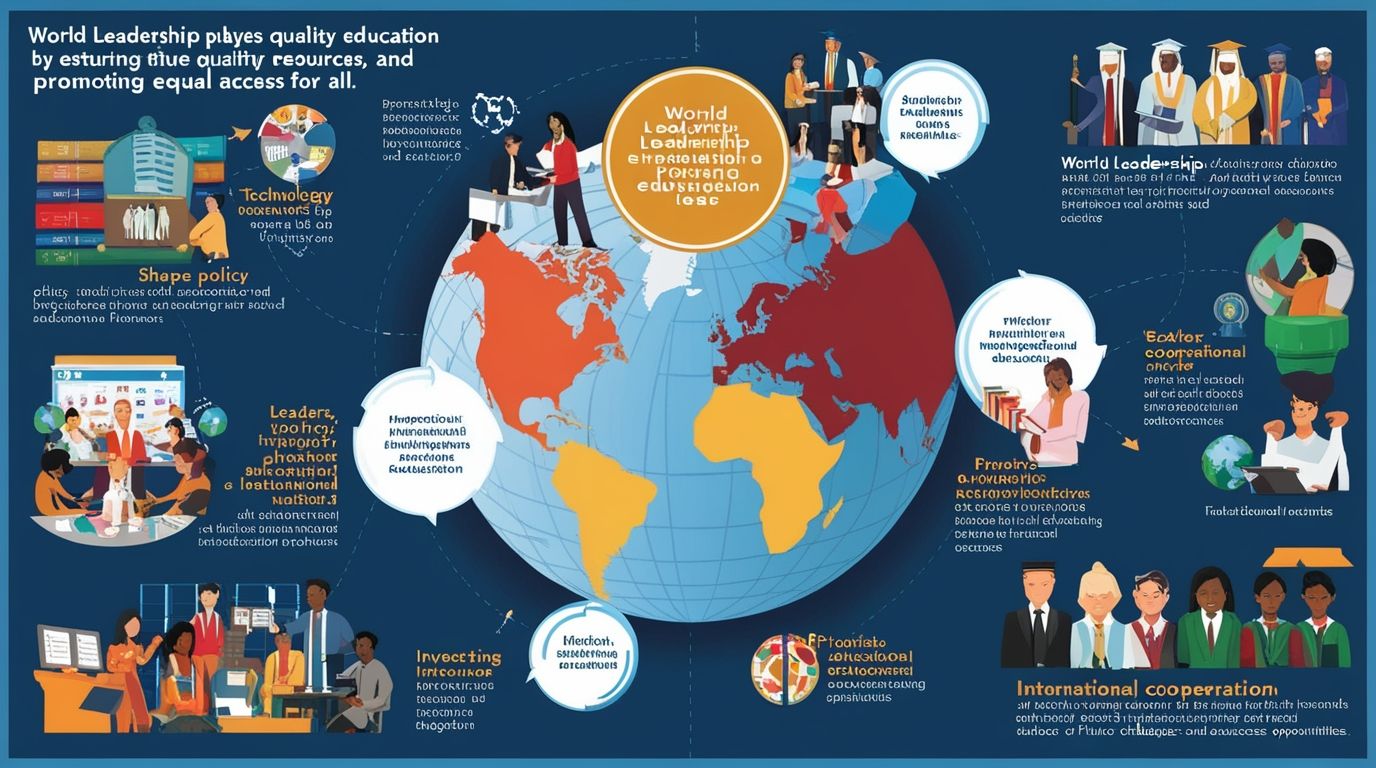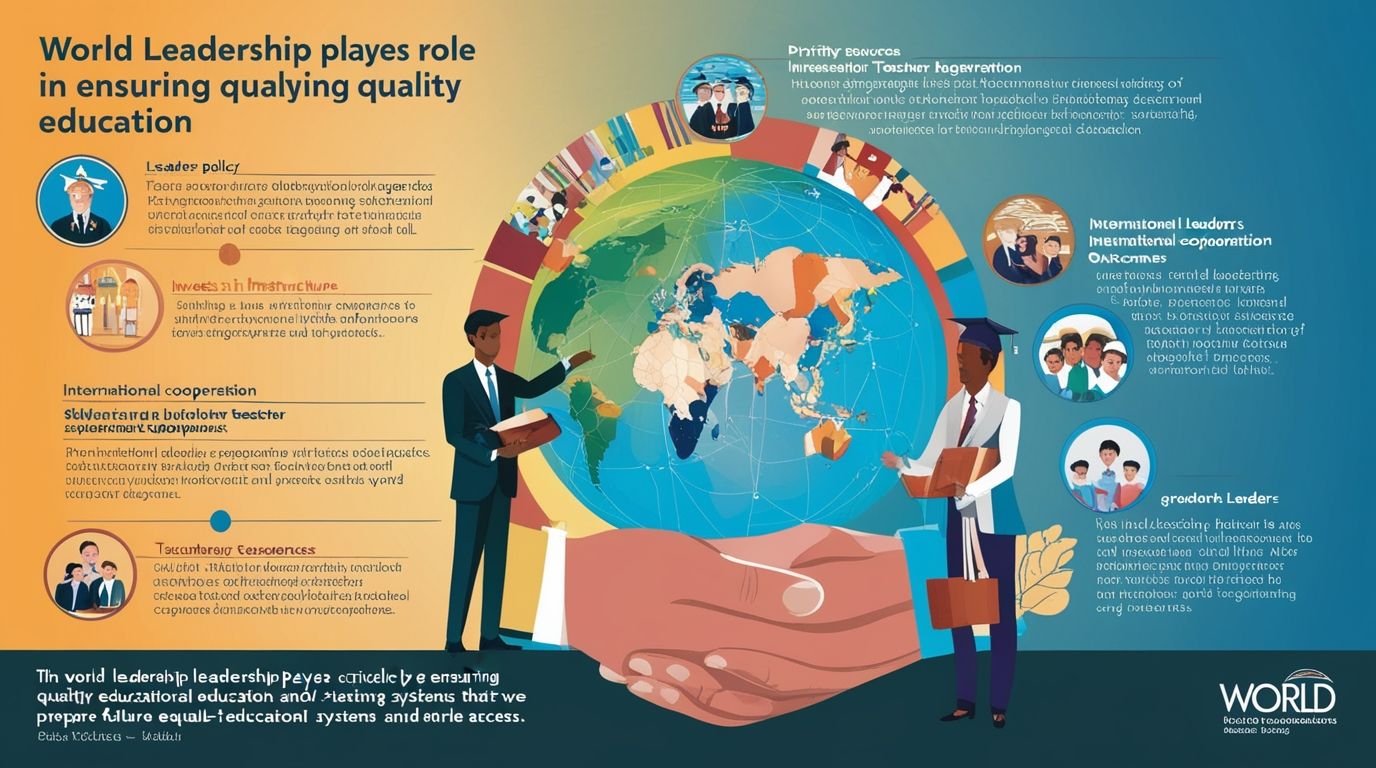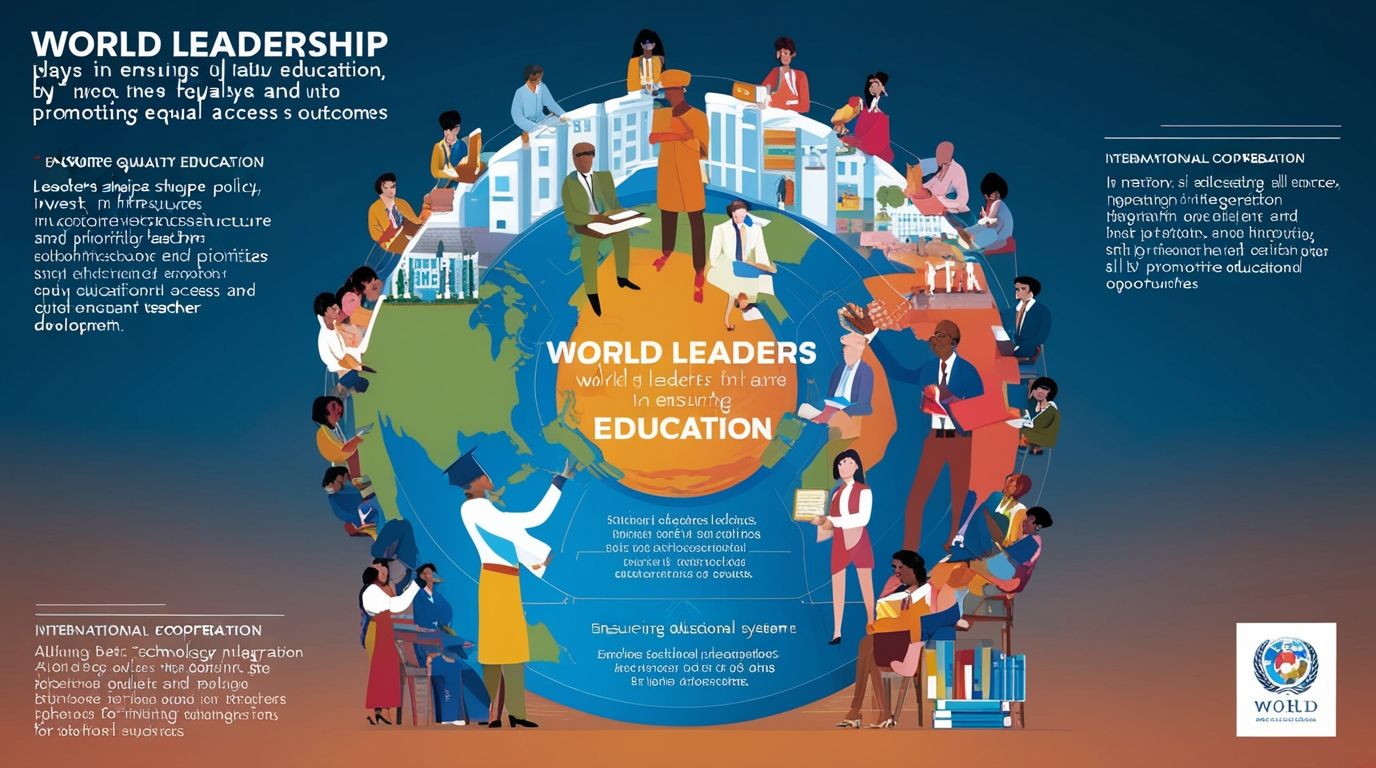Introduction
Role of World Leadership in Quality Education, Education is a cornerstone of social, economic, and political development. Ensuring quality education is a critical mandate for world leaders, as it shapes the future of a nation’s workforce, economy, and global competitiveness. In recent decades, international bodies such as the United Nations (UN), through its Sustainable Development Goals (SDGs). It have emphasized the role of quality education as a key driver of development. However, achieving this goal requires strong leadership at both national and international levels. This article examines the role of world leadership in ensuring quality education in their countries, exploring how policy decisions, resource allocation, and global cooperation contribute to this effort.
1. Setting National Educational Agendas
- Leadership and Visionary Policy Formulation
One of the primary roles of national leadership is to create and sustain a clear vision for education. Leaders must prioritize education within their national development agendas, ensuring that policies are aligned with long-term goals for improving literacy, critical thinking, and employability skills. Countries like Finland and Singapore serve as prime examples of how visionary leadership can radically transform educational outcomes.
Finland, for instance, restructured its education system in the 1970s to focus on equity and creativity, which now ranks it among the best globally. The Finnish government prioritized teacher training and reduced standardized testing, enabling teachers to innovate in the classroom. Similarly, Singapore’s government implemented strategic reforms. That shifted the focus from rote learning to critical thinking and problem-solving skills. These examples underscore the importance of leadership in policy formulation and setting a clear educational agenda that transcends political cycles.

2. Allocating Resources for Education
- Financial Investment and Infrastructure Development
Effective leadership in education also involves proper allocation of resources to build and maintain infrastructure. Develop curriculums, and ensure the professional development of educators. The allocation of adequate funds to education plays a pivotal role in ensuring the sustainability of reforms and the provision of quality education.
Countries that invest heavily in education often reap the benefits in the form of higher literacy rates, better-skilled labor, and stronger economic growth. For example, countries like Sweden and Norway, which allocate significant portions of their GDP to education, have some of the highest educational standards in the world. Adequate financial investments ensure the availability of textbooks, access to modern technology, and improved school infrastructure, which collectively enhance the learning environment.
- Human Resource Development
In addition to infrastructure, leadership must prioritize human resources by investing in teacher training and compensation. The quality of teachers is a crucial determinant of the quality of education. Successful nations, such as Japan and South Korea, have policies that ensure their teachers are well-compensated. Trained regularly, which motivates them to perform better.
However, in many developing nations, leadership struggles to balance educational funding with other priorities. Countries that fail to invest adequately in education face challenges such as overcrowded classrooms, untrained teachers, and inadequate learning materials, which ultimately hampers the quality of education.
3. Global Cooperation and Educational Development
- International Collaborations and Global Leadership
In the increasingly interconnected global landscape, international collaboration is essential for enhancing educational systems. World leaders play a critical role in fostering cooperation across borders through global organizations like UNESCO, UNICEF, and the World Bank. These organizations provide financial support, technical expertise, and policy advice to developing countries that are struggling to improve their educational systems.
The Global Partnership for Education (GPE), a multilateral fund dedicated to ensuring quality education in low-income countries, has been instrumental in driving global efforts toward this goal. The GPE’s work in supporting over 76 countries is a testament to the power of collective leadership in addressing global educational challenges. Leaders who advocate for such collaborations demonstrate an understanding that educational development in one country can have positive spillover effects on the global economy and security.
- Exchange of Best Practices
Leaders can also play an instrumental role in facilitating the exchange of best practices in education. Global forums, summits, and research initiatives allow countries to learn from one another. The Education Commission, chaired by former UK Prime Minister Gordon Brown, is an example of a global initiative aimed at reforming education systems around the world through shared knowledge and policy advice. By promoting policies that encourage international collaboration, world leaders can drive innovation and continuous improvement in educational standards.
4. Innovative Solutions and Technology Integration
- Promoting Digital Transformation in Education
As the world enters the fourth industrial revolution, technology is increasingly playing a central role in education. Leaders who embrace technological innovation in their educational policies can offer students the tools needed to thrive in a digital economy. For example, Estonia’s digital-first approach to education has made it a global leader in integrating technology into classrooms, where all schools are connected to the internet, and digital learning tools are used extensively.
The COVID-19 pandemic highlighted the importance of digital tools in education. During this time, world leaders had to make swift decisions to move learning online, underscoring the need for preparedness and technological infrastructure. Countries like New Zealand, where the government ensured rapid digital access for students, succeeded in minimizing educational disruptions. In contrast, countries with limited digital infrastructure saw significant setbacks, revealing the gap in quality education between nations.
- Championing STEM Education
Leadership plays a critical role in promoting STEM (Science, Technology, Engineering, and Mathematics) education, which is essential for preparing students for the evolving job market. Governments that emphasize STEM education tend to foster innovation and economic growth. For instance, China has made significant investments in STEM education, with its leadership prioritizing technological innovation as a key pillar of national development. In the U.S., leadership at both federal and state levels has launched numerous initiatives to promote STEM learning, recognizing its importance for national security and global competitiveness.
5. Addressing Educational Inequalities
- Targeting Marginalized Communities
One of the key challenges for world leaders is addressing educational inequality. Disparities in access to quality education exist along lines of socio-economic status, gender, ethnicity, and geography. For example, in rural areas of many developing countries, schools are often underfunded and lack basic amenities such as electricity and running water. In response, strong leadership must focus on inclusive education policies that bridge the gap between rural and urban education systems.
Countries like Rwanda have made significant strides in addressing educational inequality through targeted policies aimed at increasing access for girls and rural communities. Leaders in such countries understand that equal access to education for all segments of the population is vital for sustainable development and social cohesion.
- Promoting Gender Equality in Education
Leaders must also prioritize gender equality in education. In many regions, particularly in sub-Saharan Africa and South Asia, girls face numerous barriers to accessing quality education, including cultural practices, early marriage, and inadequate sanitation facilities in schools. Leaders who focus on gender equity initiatives, such as providing scholarships and building safe learning environments for girls, can significantly improve educational outcomes. Programs such as the Malala Fund, championed by global education advocates, highlight the role leadership can play in advancing gender equality in education.

6. Ensuring Accountability and Transparency
- Monitoring and Evaluation Systems
Good leadership involves not only setting policies but also ensuring their effective implementation. This requires robust monitoring and evaluation systems that hold educational institutions and government bodies accountable for their performance. Countries with strong accountability mechanisms, such as South Korea, have consistently outperformed others in global educational rankings.
Leaders must establish transparent systems that track the progress of educational initiatives, assess the effectiveness of teaching methods, and measure student outcomes. The use of data-driven approaches to policy-making can help identify gaps and areas that require further investment.
- Engaging Civil Society
In democratic nations, civil society plays a crucial role in holding governments accountable for their educational promises. Leaders must engage with civil society organizations, parents, and teachers’ unions to ensure that educational policies are meeting the needs of communities. This participatory approach to education reform helps ensure that the voices of all stakeholders are considered in the decision-making process, leading to more sustainable and inclusive outcomes.
Conclusion
World leadership plays a pivotal role in shaping the quality of education within countries. From setting national educational agendas to fostering global cooperation, investing in human capital, and addressing inequality, the actions of leaders directly impact the outcomes of educational systems. As the world continues to face complex challenges such as technological disruption, economic inequality, and geopolitical tensions, it is more critical than ever for world leaders to prioritize quality education. Through visionary policies, resource allocation, and international collaboration, leaders can ensure that future generations are equipped with the knowledge and skills they need to succeed in an increasingly interconnected world.
References
- UNESCO. (2017). Global Education Monitoring Report. Paris: UNESCO.
- Darling-Hammond, L. (2010). The Flat World and Education: How America’s Commitment to Equity Will Determine Our Future. New York: Teachers College Press.
- The Global Partnership for Education. (2021). Annual Report 2020. Washington, DC: GPE.
- Sahlberg, P. (2015). Finnish Lessons 2.0: What Can the World Learn from Educational Change in Finland?. New York: Teachers College Press.

6 thoughts on “Role of World Leadership in Quality Education”
Comments are closed.